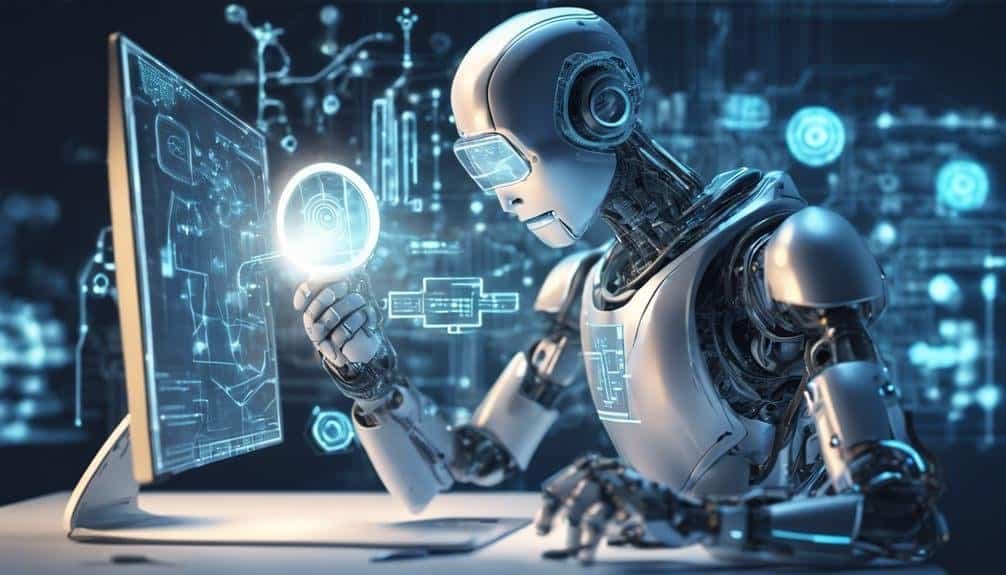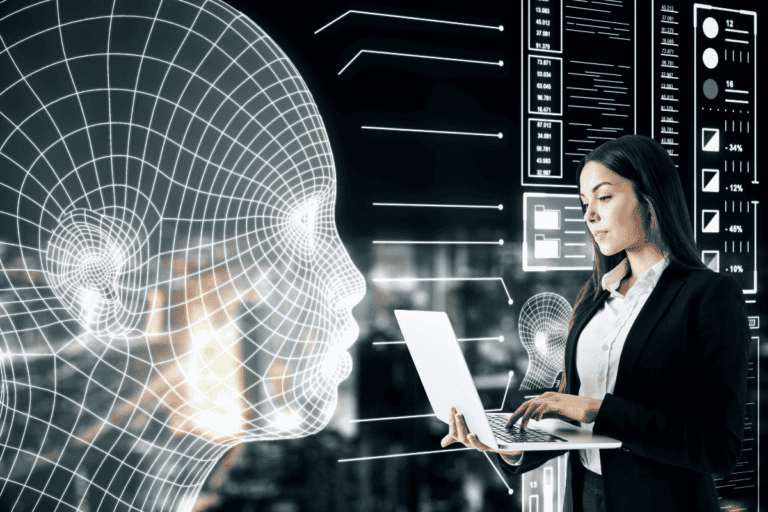AI and Intellectual Property: The Ultimate Guide
Imagine a landscape where the boundaries of innovation blend with the realm of artificial intelligence, shaping the future of intellectual property.
As you navigate through the intricate web of AI and IP, the complexities of patents, copyrights, trademarks, and trade secrets come into play.
However, it is not just about securing rights; it’s about safeguarding creations in a rapidly evolving digital era.
Explore how AI intersects with global IP laws, data privacy, open-source initiatives, and the emerging trends that are reshaping the very essence of intellectual property protection.
Key Takeaways
- Determining ownership in AI creations is complex
- Legal rights crucial in AI ownership disputes
- Continuous updates needed for AI-related IP laws
- Ambiguity in AI creation ownership requires comprehensive regulations
Overview of AI in IP
In the realm of intellectual property, AI is revolutionizing how innovations are protected and managed. AI regulation plays a crucial role in shaping the landscape of intellectual property (IP) rights. As AI continues to advance at a rapid pace, regulators are faced with the challenge of keeping up with the evolving technology to ensure that IP rights are adequately protected. The dynamic nature of AI poses unique challenges for IP laws and regulations, requiring constant updates and adaptations to address emerging issues effectively.
One of the significant AI regulation challenges in the realm of intellectual property is determining the ownership of AI-generated creations. Unlike human inventions, AI-generated works raise questions about who should be credited as the inventor or owner of the intellectual property. Current IP laws weren’t designed to address such scenarios, leading to debates and legal uncertainties surrounding AI-generated innovations.
Additionally, the question of liability for AI-generated creations also poses a challenge in IP regulation. Determining accountability when AI systems autonomously create intellectual property presents complex legal and ethical dilemmas that require careful consideration and deliberation.
Importance of Patents in AI
When considering the Importance of Patents in AI, it’s crucial to understand the benefits of patent protection in safeguarding AI innovations.
Exploring how patents drive innovation in AI technologies can provide valuable insights into the industry’s growth and development.
Additionally, being aware of the unique challenges surrounding AI patents can help navigate the complexities of protecting intellectual property in this rapidly evolving field.
Patent Protection Benefits
Securing patent protection for AI innovations offers significant advantages in safeguarding intellectual property rights and fostering technological advancements. Patents provide exclusive rights to inventors, enabling them to prevent others from making, using, or selling their patented inventions without permission. This exclusivity can be crucial in the competitive AI landscape, where innovation is highly valued. Additionally, patents can enhance the marketability of AI technologies, attracting investors and potential partners due to the protection they offer. Furthermore, having a strong patent portfolio can act as a deterrent against potential infringers, safeguarding your AI inventions from unauthorized use. International patent protection is also vital in the global market to ensure that your AI innovations are secure across various jurisdictions.
| Benefits of Patent Protection in AI | |||
|---|---|---|---|
| 1. Safeguarding intellectual property rights | 2. Fostering technological advancements | 3. Enhancing marketability | 4. Deterrent against infringers |
Innovation and Patents
By securing patent protection for AI innovations, you can establish a strong foundation for safeguarding your intellectual property rights and promoting technological progress. In the realm of AI innovation, patents play a crucial role in incentivizing inventors to disclose their groundbreaking technologies to the public in exchange for exclusive rights.
Developing effective patent strategies in the field of AI is paramount to gaining a competitive edge and ensuring that your innovations are protected from unauthorized use. When devising your patent strategy, consider factors such as the scope of protection needed, the potential for future developments, and the competitive landscape.
AI Patent Challenges
In navigating the landscape of AI patent challenges, a comprehensive understanding of the importance of patents in AI is crucial for protecting and maximizing the value of your innovations.
- AI patentability challenges: Stay updated on the evolving criteria for patenting AI inventions amidst rapid technology advancements.
- Technology advancements: Monitor how new technological developments impact the AI patent landscape and navigate emerging markets effectively.
- AI patent landscape: Analyze the current state of AI patents to identify opportunities and potential obstacles for your innovations.
- Emerging markets: Explore new markets where AI technologies are gaining traction and align your patent strategies accordingly to secure your competitive edge.
Copyright Protection for AI
Copyright protection for AI involves establishing ownership rights over the creative works produced by artificial intelligence systems. When it comes to AI creativity, a key consideration is determining who owns the copyright to works generated by algorithms. In most cases, the law attributes authorship to human creators, raising questions about algorithm ownership and the eligibility of AI-generated works for copyright protection.
Ownership of copyright for AI-generated content is a complex issue. Generally, copyright laws don’t protect works produced by non-human authors. Since AI operates based on algorithms and data inputs, it lacks the human creativity element traditionally required for copyright protection. This raises challenges in determining whether the AI system itself or its human operators should be considered the rightful copyright holders.
In cases where AI generates content, the focus shifts to the human involvement in creating the algorithm or curating the data used by the AI. If humans play a significant role in designing the AI system or selecting the input data, they may claim copyright over the output. However, this scenario blurs the lines between AI creativity and human authorship, necessitating a nuanced approach to copyright ownership in the realm of artificial intelligence.
Trademark Considerations
When considering AI and intellectual property, it’s essential to delve into trademark considerations as they play a crucial role in protecting brands and distinguishing goods or services in the marketplace. Trademark enforcement ensures that your brand identity remains unique, while brand protection safeguards against unauthorized use or infringement. Here are four key points to keep in mind:
- Trademark Registration: Registering your trademarks, including those related to AI technologies, provides legal protection and exclusive rights to use them in commerce. Conducting thorough searches before registration can help avoid potential conflicts.
- Monitoring and Enforcement: Regular monitoring of trademarks is vital to identify any potential infringements. If unauthorized use is detected, swift enforcement actions, such as cease and desist letters or legal proceedings, may be necessary to protect your brand.
- AI-generated Trademarks: With AI increasingly involved in creating content, businesses must clarify ownership rights of AI-generated trademarks. Establishing clear guidelines and agreements on ownership can help avoid disputes.
- International Considerations: When utilizing AI on a global scale, it’s crucial to understand trademark laws and regulations in different jurisdictions. Seeking trademark protection internationally can safeguard your brand across borders, ensuring comprehensive brand protection strategies.
AI and Trade Secrets
Considering the intricate nature of AI technologies and their impact on intellectual property, delving into the realm of trade secrets in relation to AI is crucial for safeguarding proprietary information and maintaining competitive advantage. AI trade secrets encompass valuable algorithms, datasets, or processes that give companies an edge in the market. To protect these trade secrets, robust confidentiality protections are essential.
Confidentiality protections play a pivotal role in safeguarding AI trade secrets. Companies must implement stringent measures such as access controls, encryption, and non-disclosure agreements to prevent unauthorized access or disclosure of sensitive information. With AI systems becoming increasingly sophisticated, ensuring the confidentiality of trade secrets is paramount to preserving innovation and competitiveness.
Moreover, the intersection of AI and trade secrets raises unique challenges. Unlike patents or copyrights that involve public disclosure, trade secrets rely on maintaining information as confidential. In the context of AI, where algorithms continuously learn and evolve, monitoring and controlling access to trade secrets become even more complex. Companies must strike a delicate balance between sharing knowledge within their organization for collaboration and restricting access to external parties to safeguard proprietary AI technologies.
Challenges in AI Ownership
When it comes to AI ownership disputes, understanding the legal rights in AI is crucial.
Protecting AI innovations requires a comprehensive approach that considers both intellectual property laws and the unique challenges posed by AI technology.
AI Ownership Disputes
Navigating the intricate landscape of AI ownership disputes requires a keen understanding of intellectual property rights and the evolving legal frameworks surrounding artificial intelligence. When it comes to AI ownership disputes and regulatory challenges, several key points need to be considered:
- Ambiguity in Ownership: Determining the rightful owner of AI-generated work can be complex due to the involvement of multiple parties in its development.
- Lack of Clear Regulations: The absence of specific laws addressing AI ownership can lead to disagreements and uncertainties.
- Contractual Arrangements: Clear and detailed contracts outlining ownership rights and responsibilities can help prevent disputes.
- International Jurisdiction: With AI development crossing borders, issues related to jurisdiction and international laws can complicate ownership disputes further.
Legal Rights in AI
Amidst the intricate landscape of AI ownership disputes, understanding the legal rights associated with artificial intelligence poses significant challenges. When it comes to AI ownership, various legal challenges arise, including issues related to patentability, copyright, trade secrets, and data rights. Below is a table outlining some of the key legal challenges in AI ownership:
| Legal Challenge | Description | Impact |
|---|---|---|
| Patentability of AI | Determining if AI inventions meet the criteria for patent protection. | Affects the ability to protect AI innovations. |
| Copyright in AI | Establishing copyright ownership for AI-generated works. | Impacts the control over AI-generated content. |
| Trade Secrets Protection | Safeguarding proprietary AI algorithms and technology. | Essential for maintaining a competitive edge in the market. |
Protecting AI Innovations
To effectively safeguard your AI innovations, understanding the intricate legal landscape surrounding AI ownership is crucial. When it comes to protecting your AI innovation, several challenges in ownership arise, requiring careful consideration:
- Ambiguity in Legal Frameworks: The evolving nature of AI technology poses challenges in applying traditional intellectual property laws effectively.
- Ownership of AI-Generated Output: Determining ownership rights over AI-generated outputs like creative works or inventions can be complex.
- Data Privacy and Security Concerns: Safeguarding sensitive data used in AI models and ensuring compliance with data protection regulations are paramount.
- Ethical Considerations: Addressing ethical implications surrounding AI ownership, such as bias and accountability, is crucial for legal protection.
AI in Patent Applications
Understanding how artificial intelligence is utilized in patent applications is crucial for grasping the evolving landscape of intellectual property protection. AI is revolutionizing the innovation process, leading to more efficient and groundbreaking inventions. In recent years, AI patentability trends have shown an increase in the number of patent applications related to AI technologies, indicating a growing recognition of the value and potential of AI in various industries.
AI in innovation has sparked a wave of new inventions, from autonomous vehicles to advanced healthcare technologies. Patent applications involving AI often focus on novel algorithms, machine learning processes, and data analytics methods that drive significant advancements in technology. The use of AI in these inventions not only enhances their functionalities but also raises complex legal questions regarding patent eligibility and inventorship.
AI patentability trends reveal a shift towards recognizing the unique contributions of AI systems in the innovation landscape. Patent examiners are now more inclined to grant patents for AI-related inventions that demonstrate technical advancement and solve specific technical problems. However, challenges remain in determining the boundaries of patent protection for AI technologies, especially in cases where AI systems autonomously generate new solutions.
AI and Fair Use
When considering AI and Fair Use, it’s crucial to understand Fair Use Basics, AI Transformative Use, and Legal Considerations in this context.
Fair Use Basics involve determining the purpose and character of the AI’s use, the nature of the copyrighted work, the amount used, and the effect on the market.
AI Transformative Use refers to how AI technologies can create new, transformative works based on existing copyrighted material.
Legal Considerations encompass the complex legal landscape surrounding AI-generated content and its relationship with Fair Use doctrines.
Fair Use Basics
Exploring the fundamentals of fair use in the context of AI involves a detailed examination of how intellectual property laws intersect with the capabilities of artificial intelligence technology. When considering fair use basics in AI, it’s crucial to understand the legal implications and the concept of transformative use. Here are key points to consider:
- Purpose and Character: Assess whether the AI’s use of copyrighted material is transformative in nature.
- Nature of the Copyrighted Work: Evaluate the original work’s nature and how it aligns with the AI’s use.
- Amount Used: Consider the quantity of the copyrighted material used by the AI.
- Effect on Market: Analyze how the AI’s use impacts the market value of the original work.
AI Transformative Use
Emphasizing the transformative nature of AI’s use of copyrighted material highlights its significant impact on fair use within intellectual property law. AI’s ability to analyze and transform data in unprecedented ways is key to this impact. Through its transformative applications, AI can generate new works that are distinctly different from the original copyrighted material. This distinction could potentially lead to these works falling under fair use exceptions. Understanding the transformative capabilities of AI is crucial in comprehending how it is reshaping the interpretation of fair use.
The revolutionary potential of AI is evident in its capacity to create unique art pieces, compose original music, and produce innovative written content. These transformative applications challenge traditional perspectives on intellectual property rights. Consequently, there is a need to reevaluate how fair use is interpreted and applied in the realm of AI-generated content. This shift prompts a fresh examination of the boundaries and considerations involved in assessing fair use within the context of AI.
Legal Considerations
Considering the legal implications of AI in relation to fair use involves analyzing how transformative applications of AI impact the interpretation and application of intellectual property laws.
- Interpretation Challenges: AI’s ability to generate content raises questions about fair use boundaries.
- Fair Use Guidelines: Courts may need to adapt fair use doctrines to accommodate AI-generated content.
- Contractual Obligations: Determining ownership and usage rights becomes complex with AI involvement.
- Liability Risks: Understanding who’s responsible for AI-generated content in terms of infringement or misuse is crucial.
Licensing AI Technology
When licensing AI technology, it is crucial to carefully review the terms and conditions to ensure that your intellectual property rights are adequately protected. Understanding licensing challenges and market trends is essential in navigating the dynamic landscape of AI technology partnerships and revenue streams. To provide a clearer perspective, let’s examine a table outlining key considerations:
| Consideration | Description | Importance |
|---|---|---|
| Licensing Challenges | Identifying potential roadblocks and hurdles in the licensing process. | Crucial for negotiation and risk assessment. |
| Market Trends | Staying informed about the latest trends and demands in the AI market. | Helps in aligning licensing strategies with market needs. |
| Technology Partnerships | Establishing strong partnerships for tech support, innovation, or distribution. | Aids in enhancing product quality and market reach. |
| Revenue Streams | Diversifying income sources through licensing agreements and royalties. | Vital for sustainable financial growth and business scalability. |
This table provides a structured overview of the critical elements that should be considered when licensing AI technology. By carefully evaluating these aspects, you can maximize the benefits of your licensing agreements while safeguarding your intellectual property rights.
AI Infringement Cases
Exploring recent AI infringement cases reveals the complexities and legal implications surrounding the unauthorized use of AI technology. When it comes to AI liability and compliance, understanding these cases can provide valuable insights into how intellectual property laws are being tested in the realm of artificial intelligence.
Key Points:
- Direct Infringement: Courts have grappled with the question of whether AI systems can be held directly liable for copyright or patent infringement when they autonomously create infringing works or products. This raises concerns about the accountability of AI systems for their actions.
- Contributory Infringement: Some cases have delved into the concept of contributory infringement concerning AI technology. This occurs when individuals or companies knowingly contribute to or induce infringement by providing AI tools to others who then use them for unlawful purposes.
- Indirect Liability: The issue of indirect liability in AI infringement cases involves determining if entities that deploy AI systems can be held responsible for the infringements committed by those systems. This raises questions about the level of control and oversight necessary to ensure AI compliance with intellectual property laws.
- AI Compliance Challenges: These cases highlight the challenges in ensuring AI compliance with intellectual property laws. As AI systems become more autonomous and capable of independent decision-making, determining how to align their actions with legal requirements becomes increasingly complex.
AI Ethics and IP
AI Ethics intersect with Intellectual Property in the realm of artificial intelligence where ethical considerations guide the responsible development and use of AI technologies within the framework of intellectual property laws. The ethical implications of AI in relation to intellectual property are vast and critical. As AI technology advances, questions arise regarding ownership rights, data privacy, and the societal impacts of AI-generated content.
One of the key ethical implications is the question of ownership of AI-generated work. When AI systems autonomously create content, such as art, music, or literature, determining the rightful owner of that intellectual property becomes complex. Should it be the creator of the AI, the owner of the AI, or the AI itself? This issue raises significant ethical concerns about incentivizing innovation while ensuring fair compensation and recognition for creators.
Moreover, the societal impacts of AI on intellectual property are substantial. AI’s ability to analyze vast amounts of data and generate new works challenges traditional notions of creativity and authorship. This shift calls for a reevaluation of copyright laws to adapt to the evolving landscape of AI-generated content. Additionally, the ethical use of AI in intellectual property enforcement, such as detecting infringement or plagiarism, requires careful consideration to balance innovation and protection.
Global IP Laws for AI
Navigating the complexities of global intellectual property laws in the context of artificial intelligence requires a nuanced understanding of jurisdictional nuances and emerging regulatory frameworks. When it comes to AI, the landscape of intellectual property (IP) protection is intricate and ever-evolving. Here are four key points to consider:
- International Treaties: Understanding international treaties is crucial when dealing with AI and IP. Treaties like the Agreement on Trade-Related Aspects of Intellectual Property Rights (TRIPS) set out minimum standards for IP protection, ensuring that AI innovations are safeguarded across borders.
- Regulatory Compliance: Compliance with global IP laws is essential for AI development and deployment. Different countries have varying regulations governing patents, copyrights, and trademarks concerning AI technologies. Staying compliant with these laws is paramount to protect your AI creations.
- Enforcement Mechanisms: Knowing the enforcement mechanisms available under different global IP laws is vital. These mechanisms ensure that your AI inventions are safeguarded against infringement, providing legal recourse in case of violations.
- Emerging Frameworks: Stay updated on emerging regulatory frameworks related to AI and IP. As AI continues to advance, new laws and guidelines specific to AI inventions are being developed. Being aware of these evolving frameworks is crucial to protect your AI innovations effectively.
AI and Data Privacy
When considering AI and data privacy, it’s crucial to address the privacy concerns that arise from the vast amounts of data AI systems collect and analyze.
Data protection regulations play a pivotal role in safeguarding sensitive information and ensuring compliance with privacy standards.
Understanding the intersection of AI and data privacy is essential for creating ethical and secure AI technologies.
Privacy Concerns With AI
In the realm of intellectual property, the intersection of AI and data privacy raises significant concerns regarding the protection of personal information. When delving into privacy concerns with AI, it’s crucial to acknowledge the following:
- Data Collection: AI systems often rely on vast amounts of data, raising questions about the extent and ethics of data collection practices.
- Surveillance Concerns: The use of AI in surveillance technologies can lead to privacy infringements and potential misuse of personal information.
- Algorithmic Bias: AI algorithms may inadvertently perpetuate biases, impacting privacy rights and data protection.
- Security Risks: With the increasing reliance on AI for data processing, vulnerabilities in AI systems could lead to breaches compromising sensitive personal data.
Data Protection Regulations
Data protection regulations play a critical role in safeguarding individuals’ privacy rights amid the increasing integration of AI in data processing and decision-making systems. Ensuring compliance with data protection laws is essential to prevent unauthorized access to sensitive information and mitigate the risks of data breaches. Implementing robust data encryption measures is crucial to safeguard data integrity and confidentiality in AI systems. In the event of a data breach, companies must adhere to strict reporting requirements to notify affected individuals and regulatory authorities promptly. By upholding data protection regulations, organizations can foster trust with their customers and uphold ethical standards in the usage of AI technologies.
| Data Encryption | Data Breach |
|---|---|
| Secure transmission | Incident response |
| Encrypted storage | Notification process |
| Access control | Investigation |
| Privacy protection | Remediation steps |
| Compliance checks | Prevention strategies |
AI and Open Source
Open Source licenses play a crucial role in shaping how AI technologies can be shared and developed collaboratively. When it comes to AI and Open Source, there are several key points to consider:
- Open Source Collaboration: Open Source licenses promote collaboration among developers by allowing them to view, modify, and distribute the source code of AI technologies freely. This fosters innovation and accelerates the development of AI applications.
- Ethical Implications: The use of Open Source licenses in AI raises ethical considerations regarding transparency, accountability, and bias. By making AI algorithms open and accessible, it becomes easier to identify and address ethical issues such as algorithmic bias and fairness.
- Community Engagement: Open Source encourages community engagement in AI projects, enabling developers from diverse backgrounds to contribute their expertise. This leads to the creation of more robust and inclusive AI solutions that cater to a wider range of societal needs.
- Knowledge Sharing: Open Source licenses facilitate knowledge sharing within the AI community, allowing researchers and practitioners to learn from each other’s work. This collective learning environment promotes continuous improvement and drives advancements in AI technology.
Future Trends in AI IP
Amidst the rapid advancements in artificial intelligence (AI), the landscape of intellectual property (IP) is evolving to accommodate the unique challenges and opportunities presented by AI technologies. As we look to the future, two key trends are likely to shape the intersection of AI and IP: AI regulation trends and IP strategy evolution.
AI regulation trends are becoming increasingly important as policymakers seek to strike a balance between fostering innovation and protecting the rights of AI creators. Countries around the world are grappling with how to regulate AI technologies to ensure they’re used ethically and responsibly. This evolving regulatory landscape will have a significant impact on how AI-related inventions are protected and commercialized.
Concurrently, the evolution of IP strategies is crucial for companies looking to leverage AI technologies effectively. As AI continues to drive innovation across industries, businesses must adapt their IP strategies to account for the unique challenges posed by AI-generated inventions. This may involve reevaluating traditional approaches to IP protection, such as patents, copyrights, and trade secrets, to ensure they’re tailored to the intricacies of AI technology.
Conclusion
In conclusion, navigating the intersection of AI and intellectual property can be a complex and ever-evolving journey. From patents to trademarks, copyright to trade secrets, global laws to data privacy concerns, the landscape is vast and intricate.
As technology continues to advance, the importance of protecting AI innovations becomes even more crucial. Embrace the challenge of safeguarding your AI creations with diligence and foresight, as the future holds limitless possibilities for intellectual property in the digital age.







